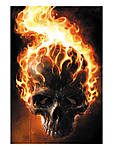1⁄35Eine kleine Krieger
7
Comments
down & dirty
An area often over looked and under worked is the lower hull and running gear. It is important to include this area in your wash stages as well as chipping and streaking effects. In this way we can build up many layers of effects on the lower hull and running gear to create a convincing over all look. Simply throwing mud at the lower hull will not create a convincing appearance. The lower hull of real vehicles would be subjected to chips and scratches as well as leaking fluids. The effects on the lower hull must also be tied into the upper hull, rear hull, fenders, and glacis plate as well. At this stage I begin to move farther away from a linear process and begin to switch back and forth between chipping, washes, and streaking effects, building each effect up in subtle layers until the desired cumulative effect is achieved. The 38(t) has excellent surface detail on the lower hull, it would be a shame to neglect these details! Rivet heads & panel seams are treated to the full barrage of washes, chipping, scratches, dust, dirt, mud, & fluids. It is critical at this stage that the road wheels be treated to the same weathering that the lower hull is subjected to. This will tie these 2 features together and give a natural and convincing appearance to the vehicle. This is an excellent opportunity to address the rear hull as well. This area will need to be treated to the same dirt, dust, & mud tones as the areas in direct contact with the Earth. This area offers the opportunity to portray one of my personal favorite weathering effects! The appearance of hydraulic fluids, grease, & Fuel leaking into and over layers of built up dust & mud! These type of effects are yet another example of how building up our weathering in layers is critical to creating depth as well as a convincing over-all appearance. While we are working with the engine fluids, the next logical place to move to is the engine deck. On the 38(t) the engine deck is composed of moveable hinged access hatches. This type of environment would have been accessed by the crew regularly and lends itself to the heavier chipping and scratches created by crew and mechanics.Comments
What a wonderful Build. I just love it! Great Finishing description. Well done! Thanks for sharing.
Gary
MAY 20, 2012 - 11:14 AM
Got to see this one up close and personal and let me tell you it looks even better in person.
Top rate painting and a great article Iain.
MAY 21, 2012 - 03:16 PM
Hello,
the right translation in german must be: "Ein kleiner Krieger".
"Eine kleine" is the female form.
MAY 21, 2012 - 06:52 PM
Andreas,
Thank you very much for this translation. Looks like I should have paid much more attention in highschool German or consulted 1 of a few friends who speak the language.
Thank you for checking out the 38(t) and perhaps next time I can check with you for translation? Thank you my friend.
MAY 22, 2012 - 02:38 AM
Thanks for the info Andreas, I learned something new (again!)
I usually refer to vehicles (and even models) in the female form so this works for me
I bet I'm not the only one that says "come on baby" when I want my car to do something that she just doesn't want to do, or "that's my girl" when she does
MAY 22, 2012 - 12:28 PM
Hello,
then you must write " Eine kleine Kriegerin" because "Krieger" is male form.
Ok, enough of teaching.
MAY 22, 2012 - 06:11 PM
Copyright ©2021 by Iain S Hamilton. Images and/or videos also by copyright holder unless otherwise noted. The views and opinions expressed herein are solely the views and opinions of the authors and/or contributors to this Web site and do not necessarily represent the views and/or opinions of Armorama, KitMaker Network, or Silver Star Enterrpises. All rights reserved. Originally published on: 2012-05-21 00:00:00. Unique Reads: 14016
















